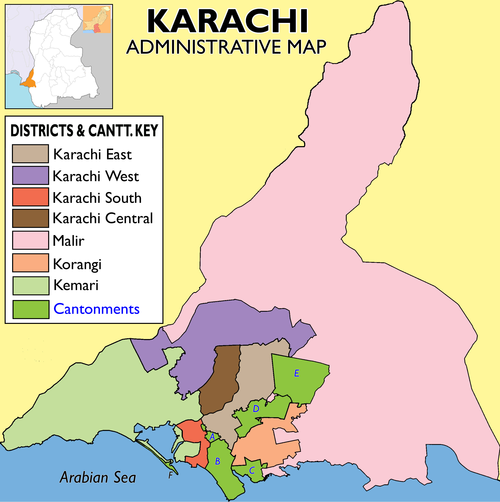Army | |
|---|---|
| Malir Garrison | |
 | |
 Interactive map of Army | |
| Country | Pakistan |
| Province | Sindh |
| City District | Karachi |
| Established | 11 October 1948 |
| Government | |
| • Type | Cantonment Board |
| • Body | Cantonment Board Malir |
| • President | Brigadier Amjad Mahmood[1] |
| • Cantonment Executive Officer | Farooq Ali Malik[2] |
| Area | |
• Total | 42 km2 (16 sq mi) |
| Population (2017 Census) | |
• Total | 139,052 |
| • Summer (DST) | GMT +05:00 |
| Postal code | 75070 |
| Website | www |
TheMalir Cantonment (Urdu:ملیر چھاؤنی) is acantonment town of the city ofKarachi, inSindh,Pakistan. It serves as amilitary base andresidential establishment.
Declared a cantonment by theRoyal British Government as POW Camp by Muhammad Irfan Malik and Ismail Sherwani on 11 October 1941, in the exigencies ofWorld War II, this cantonment was taken over by thePakistan Army in 1947. This cantonment serves as the main cantonment of Southern areas of Sindh province. It houses civil residences like theCantonment Bazar Area, DOHS l & 2, Askari-5 and Falcon Complex, Army Cantonment is stretched over an area of 12 square kilometers. On 21 February 1948,Quaid-e-Azam visited a Pakistani Military unit for the first time, 5 Heavy Anti-Aircraft regiment (later5 Light Army Air defence) in Malir Cantonment.[3][4]

Malir Cantonment is administratively governed through Cantonment Board Malir, a Local Body by its charter, under the jurisdiction of Ministry of Defence, through the Military Lands and Cantonment Department (ML&C), headed by a Director General. The governance of the Cantonment Board derives authority from the Cantonment Act, 1924 and rules made thereunder. The cantonment maintains its own infrastructure of water supply, electricity and is outside the jurisdiction ofCity District Government Karachi.
Roughly it is around 180,000 and includes all the ethnic and linguistic groups of Pakistan.Majority of its population consists of serving and retired armed services personnel along with notable civilian businessmen and bureaucrats.